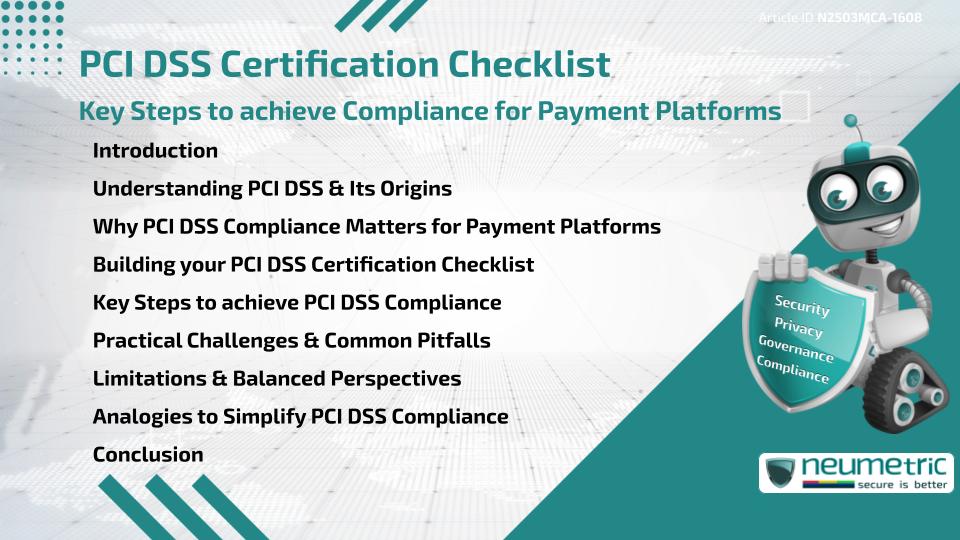Introduction
Handling Payment Information is a huge responsibility for any Platform. Whether you are running an E-commerce Website or a Mobile Payment App, protecting Customer Data is critical. This is where the PCI DSS Certification Checklist comes in. It helps organisations systematically meet the Payment Card Industry Data Security Standard [PCI DSS] requirements to ensure a secure environment for Cardholder Data. In this article, we explore the checklist, its importance & how to navigate Compliance confidently.
Table of Contents
ToggleUnderstanding PCI DSS & Its Origins
The Payment Card Industry Data Security Standard [PCI DSS] was introduced in 2004 by major Credit Card companies like Visa, Mastercard & American Express. Its goal was to create a unified Security Framework after several high-profile data breaches impacted Consumer Trust. Think of PCI DSS as the traffic laws for Digital Payment highways. Everyone handling Payment Cards must follow these rules to prevent accidents — in this case, data breaches.
Why PCI DSS Compliance Matters for Payment Platforms
For Payment Platforms, Compliance is not just about avoiding penalties. It builds Customer Trust & protects the Platform’s reputation. A single data breach can cost millions & permanently damage a brand. Following the PCI DSS Certification Checklist ensures your systems are robust enough to guard against known Vulnerabilities. It also helps align your operations with Global Standards, making it easier to partner with Banks & Payment Processors.
Building your PCI DSS Certification Checklist
Your checklist should include:
- Identifying all Payment Data Flows
- Mapping where Cardholder Data is stored, processed or transmitted
- Assigning roles & responsibilities for security tasks
- Documenting all Security Policies & Procedures
- Scheduling regular Vulnerability Scans & Audits
Each step ensures you do not miss critical requirements & stay on course throughout the Compliance journey.
Key Steps to achieve PCI DSS Compliance
Let’s dive deeper into the key steps you should include in your PCI DSS Certification Checklist:
Understand the Scope
Before starting, clearly define the Scope. Identify all systems & processes interacting with Cardholder Data. Reducing Scope through segmentation can make Compliance simpler.
Secure the Network
Install Firewalls, change default passwords & ensure all devices are securely configured. A locked gate keeps the Threats at bay.
Protect Cardholder Data
Encryption is your best friend here. Whether the data is at rest or in transit, ensure it is protected with strong Encryption methods.
Maintain a Strong Access Control Policy
Limit access to Sensitive Information to only those who need it. Think of it as giving house keys only to trusted family members, not the whole neighborhood.
Monitor & Test Networks Regularly
Test security systems regularly & monitor the access to network resources. Continuous vigilance helps spot issues before they escalate.
Maintain an Information Security Policy
Document clear Security Policies & update them regularly. Make everyone in your organisation aware of these Policies.
Practical Challenges & Common Pitfalls
Following the PCI DSS Certification Checklist can seem straightforward, but real-world challenges can complicate things. Many Platforms underestimate the complexity of their Cardholder Data environment. Others focus on passing the Audit rather than maintaining ongoing security. Additionally, Small Businesses may lack the technical resources to implement strong encryption or network monitoring, leaving gaps that attackers could exploit.
Limitations & Balanced Perspectives
It is important to understand that PCI DSS Compliance does not guarantee complete Security. It is like wearing a seatbelt; it dramatically reduces Risk but does not prevent all injuries. Also, Compliance is a point-in-time activity, while Security requires constant attention. Businesses should combine PCI DSS efforts with broader Cybersecurity practices for comprehensive Protection.
Conclusion
Following the PCI DSS Certification Checklist brings discipline to your Payment Platform’s security journey. By taking a step-by-step approach, understanding the reasoning behind each requirement & staying vigilant after certification, organisations can build strong foundations for long-term success. The checklist is more than just a Compliance exercise — it is a blueprint for trust, reliability & growth.
Takeaways
- PCI DSS Compliance builds Trust & protects brand reputation.
- A structured PCI DSS Certification Checklist helps manage the process effectively.
- Regular monitoring & updates are crucial even after certification.
- PCI DSS Compliance should be part of broader Cybersecurity efforts.
- Practical challenges require flexibility, resourcefulness & commitment.
FAQ
What is the PCI DSS Certification Checklist?
The PCI DSS Certification Checklist is a structured list of steps & requirements that businesses must follow to achieve Compliance with the Payment Card Industry Data Security Standard [PCI DSS].
Why do Payment Platforms need a PCI DSS Certification Checklist?
Payment Platforms use the PCI DSS Certification Checklist to systematically secure Cardholder Data, meet Industry Standards & build Customer Trust.
How often should a Payment Platform review its PCI DSS Certification Checklist?
It is best to review the PCI DSS Certification Checklist annually or whenever there are significant changes in the Payment environment or technology stack.
Is achieving Compliance with the PCI DSS Certification Checklist enough to guarantee security?
No, while the PCI DSS Certification Checklist reduces Risks, continuous Security Monitoring & improvements are essential for full protection.
What happens if a business ignores the PCI DSS Certification Checklist?
Ignoring the PCI DSS Certification Checklist can lead to data breaches, loss of Customer Trust, heavy fines & potential legal action.
How can a Small Business manage the PCI DSS Certification Checklist requirements?
Small Businesses can manage the PCI DSS Certification Checklist by segmenting their Payment Systems, using secure hosting providers & consulting with qualified security assessors.
Can a business outsource PCI DSS Compliance tasks?
Yes, businesses can outsource tasks like Vulnerability scanning or Penetration Testing but remain responsible for overall Compliance according to the PCI DSS Certification Checklist.
Are there tools to help with the PCI DSS Certification Checklist?
Yes, many security vendors offer tools for Vulnerability management, encryption & logging to help automate parts of the PCI DSS Certification Checklist.
Need help?
Neumetric provides organisations the necessary help to achieve their Cybersecurity, Compliance, Governance, Privacy, Certifications & Pentesting goals.
Organisations & Businesses, specifically those which provide SaaS & AI Solutions, usually need a Cybersecurity Partner for meeting & maintaining the ongoing Security & Privacy needs & requirements of their Clients & Customers.
SOC 2, ISO 27001, NIST, HIPAA, HECVAT, EU GDPR are some of the Frameworks that are served by Fusion – a centralised, automated, AI-enabled SaaS Solution provided by Neumetric.
Reach out to us!


